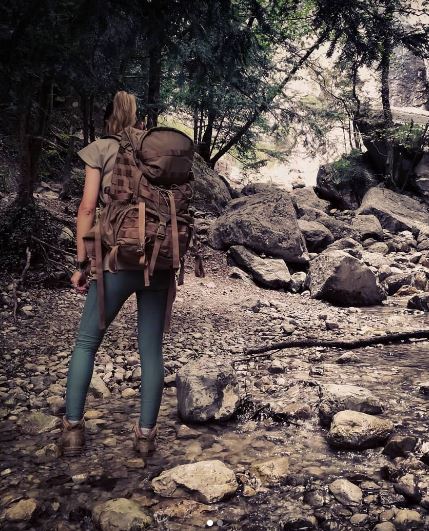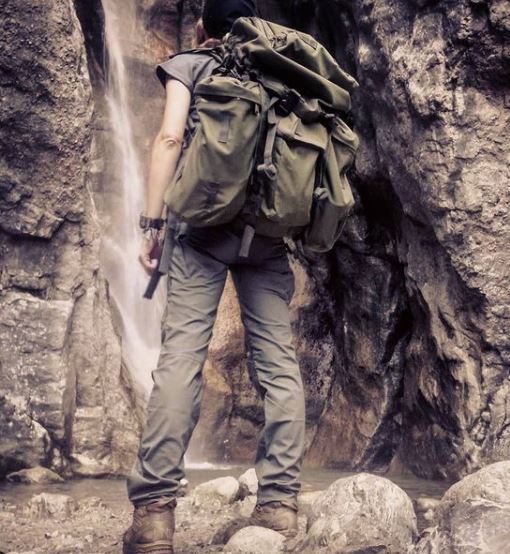This article was written from a European point of view …
“Bushcraft” is a term for wilderness skills and is the practice of surviving”
~ Dave Canterbury
What leads us to the initial selection of our gear is not comfort, but experience. After we’re experienced, then we can focus on comfort. It all comes down to how much time we spend offgrid, far from our usual comforts.
To me, Bushcraft is my home away from home. My backpack is my ally, my companion, and part of my clothing. Occasionally, it can be turned into a Bug-Out-Bag. I’m sure you know what I’m getting at.
Personally speaking, I’ve tested more than twenty different backpacks in my life. There’s a long list of reasons and criteria that I’ve considered.
All about … our body
“You must master a unique skill set that includes fire-craft, navigation, trapping, creating shelter, tracking, and the use of tools, both modern and primitive.”
~ Dave Canterbury
Our body is in constant change. As a child first, and teenager later, who spent most of my weekends in the woods with my parents, I can say that my very first backpack was a colorful, lightweight Invicta. I still remember orange and blue backpack. We can say that it was a real cult back in the 1990s! In those years I used to pack only a waterproof jacket in it, along with a small bottle of water, and a couple of snacks. It used to be my inseparable companion.
Later on, my passion for the Great Outdoors, led me into the selection of a more structured backpacks. However, I was very skinny, with a weak back. So, throughout the years, I opted out for light backpacks which was, in my personal perspective, a good compromise between efficiency and weight.
I essentially let my body decide what was the best to look for. Later on I realized that was a huge mistake. Instead of choosing comfort, I needed to work on myself, and on my health too. I think many of you could share my story. For this reason I started to opt for different gear.
All about… our mindset
It goes without saying that our mindset plays a huge role in the selection of our gear. Depending on how much time we will spend in the Great Outdoors, we pick the right stuff. One day, one week. We calibrate our decisions on the requirements given by circumstances. In fact, it is pretty common inside the Bushcraft Community to have more than one backpack.
I make no exceptions; I consider the overnights, the distances I want to cover, and obviously, which kind of particular equipment I want to pack besides the essentials.
In fact, along with Fire, Survival and Medi-Kits, as a Tracker I add my Tracking gear as well as the proper cooking set, sleeping systems and so on.
All about… our knowledge
The more we know, the less we carry. I reckon that probably everyone of us did the very opposite at the beginning of our journey into Bushcraft! We used to carry a lot of extra stuff we really didn’t need to. Sometimes two of each piece, in case… well, you never know!
Later on, thanks to courses taken and gaining knowledge, we tend to reduce what we pack. Less is more, also in our Bushcraft activities. Some items have more than one purpose and for this precious reason we learned how to compact our gear, and even how to better pack each single piece inside our backpacks.
All about… Bushcraft Backpacks
This is my personal selection, and my requirements may not match yours. I always have a thing on; tactical gear,because of its durability and reliability. Honestly, throughout the years, I have never been disappointed by this kind of equipment.
Even if I tested, discharged, and eventually opted out for different brands and models, in the last ten years I remained committed to this concept.
Personally speaking, I carry everything I need inside my backpack, and occasionally inside external pouches attached by molle system. Due to my size (5,6 feet tall for 117 lb), I always found it very uncomfortable to wear a belt with pouches attached.
My backpacks contain the following items:
Survival Kit (with purification systems and navigation devices)
Additional clothes
Sleeping system
Repairing Kit
Light system
Tracking Kit
Cooking set
Med-Kit
Fire Kit
It goes without saying that the Survival Kit and the Med-Kit are placed in easy reach locations due to their importance. In my opinion, a good Bushcraft Backpack should 100% fit your body as well as your needs, while always being:
Comfortable
Breathable
Resistant
Durable
Roomy
Here’s my personal selection of some of the best Bushcraft backpacks on the market:
1. Ferrino “Tuscania”
It has been a guilty dream of mine for a long time. I observed and tried it several times in tactical stores, until I could afford it.

This backpack perfectly fits my back and my shoulders. It has a main, central area that you can reach from a top entrance or from an external zip. It also features a roomy bottom space where I usually place my sleeping system.
The back is completely breathable, as so are the shoulder straps. A large belt allows you to better distribute and hold the weight you are carrying.
The top part of the backpack is layered into two different areas sealed by solid zippers. It was designed to attach several side pouches thanks to a well structured molle system.
Pros
Tough, roomy, breathable back and shoulder straps. 50 lt
Cons
Expensive, thin belt, off size for hand luggage when travel by aeroplanes. The pouches need to be purchased separately
2. Berghaus “Vulcan II”
The Vulcan II features a traditional alpine design, with two roomy side pouches for canteens and a medi-kit, and a survival kit. It’s more bulky and squat than the Tuscania. It has a central main area closed by the largest top pouch I’ve ever seen. The shoulder straps are, in my personal opinion, are too much thin for this kind of backpack.

I usually resort to this when I need to carry my bivy tent, due to the extra space required.
Pros
Tough, roomy, solid zip, breathable back and good belt. 100 lt
Cons
Thin shoulder straps. The pouches need to be purchased separately. No molle system provided.
3. Defcon 5 “Bushcraft Backpack”
This 35 Lt is a good compromise between gear with tactical appearance and Bushcraft internal design.
 In fact, it features three internal fishnet pouches than you can also easily remove with asix plastic carabiners. The back and the shoulder straps are very breathable, and so is the belt, which has also a tiny zip pouch. I’ve tested it in different climate conditions and it never let me down.
In fact, it features three internal fishnet pouches than you can also easily remove with asix plastic carabiners. The back and the shoulder straps are very breathable, and so is the belt, which has also a tiny zip pouch. I’ve tested it in different climate conditions and it never let me down.
Pros
Compat, roomy, breathable back, shoulder straps and good belt. 35 lt
Cons
Tiny pouch on the belt, closure at Y (it can open if stuffed too much!)
4. Helikon-Tex “Ratel MK2”
Tiny, compact, with quick release. It features two big and rectangular external pouches and a main one which make this backpack reliable and very comfortable if you don’t have to carry much weight.

In fact, the weak point is the thin belt, which could be quite useless in case you need to support the entire weight on your belly.
Pros
Tough, compact, breathable back . Good zip. 25 lt
Cons
Thin belt.
5. Tasmanian Tiger “Range Pack MKII”
A little bit bulky for a thin girl like me, the Range Pack MKII is an old style backpack. Unless you are a big guy, it doesn’t allow you to raise the neck on steep slopes.
The poor visibility is exacerbated by the difficult to get to side pockets in an easy way. In fact, you have to drop the backpack on ground in order to reach what you need.
Despite these cons, it is a super solid backpack, with a very big main area. Side pouches can be purchased separately, but I highly suggest to test it as is before rushing to buy extra space.
Pros
Tough, big, solid, breathable shoulder straps and back . Good belt and zippes. 100 lt
Cons
Definitely bulky on skinny people.
6. Tasmanian Tiger “Essential Pack MKII”
This 9 liters is the ideal back up backpack when you need to move fast and you only want to carry the essentials with you. Nonetheless, its total molle system allows you to customize it to your needs.
Pros
Thin, resistant, versatile. Good shoulder straps and back . Molle pouches easily attachable. 9 lt
Cons
Lack of any belt.
Kyt Lyn Walken
- Certified Wildlife Conservation Ranger at Conservation Ranger Operations Worldwide
- Official Representative & Instructor at Hull’s Tracking School
- Directora de Rastreo Humano por Dynamic Tracking (Spain)
- The way of Tracking – European Mantracking School
